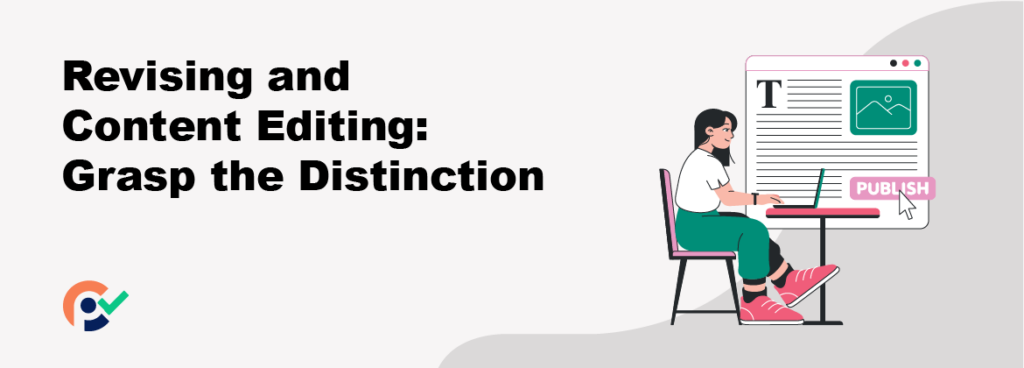
Revising and Content Editing: Grasp the Distinction
Writing quality content is not a one-time process; it involves multiple steps. Two crucial steps in this process are revising and editing. Many writers try to handle both steps simultaneously but they are distinct tasks.
Often, writers don’t understand their differences and consider them similar. Do you also need clarification about these steps and have multiple questions?
So, don’t worry; we are here to address such queries. In this article, we’ll explore the differences between revising and editing and offer tips to help you handle these steps more efficiently without sacrificing quality.
What is Revising?
Revisions should be the first thing done after writing the paper’s first draft. Revisions begin with a re-read of what has been written. As you go through your content ensure that nothing needs adding or removing.
Are any of your claims sufficiently substantiated? Are there missing citations? Does it make sense? Does the writing logically flow from one section to the next?
Now, during the revision process, you will have a chance to interrogate your work and fix the major problems found. You don’t need to be as concerned about typographical or word-choice errors; you can correct those later.
What is Editing?
After revision, the next stage is content editing. While revising focuses on making major changes to the overall structure of your content, then editing works with sentence structure and phrasing changes. It deals with whether your writing conveys your intended meaning.
As you edit, you need to check on word choice, whether any of your sentences are too long or short, and whether the punctuation is correctly applied. This is also the stage where you are supposed to ensure that your content follows the proper citation format.
Does your content need to be written according to the MLA, APA, or Chicago styles? Have you written and formatted your headings in the proper title case? Is the tone of your content appropriate for your audience? Addressing these details during editing will help polish your work and make it more effective.
Strategies for Content Editing and Revision
Take a Break After Writing
There’s nothing more frustrating than being under the gun for a thorough content edit. Feeling rushed is a distraction and an easy way to miss details. Whenever you are writing something, it’s crucial to set time aside for content editing and revising.
Avoid this pressure by taking at least a day in between writing and editing. This break allows you to return to your work with a fresh perspective to identify and correct mistakes. It can help you to review your work more objectively and thoroughly. This approach helps ensure that your final draft is polished and mistakes-free.
Review Your Sentence Flow
During the editing process, it’s important to review your sentence flow and ensure they align the ideas properly. Think about how each sentence fits into the overall picture and helps the reader move from one idea to another. Your sentences should connect naturally with each other to create a smooth reading experience.
By fine-tuning your sentence structure, you’ll make your writing clear and more engaging, ensuring your message comes through effectively. Keep your sentences direct and easy to understand for better content flow. If you find any sentences that are too long or filled with overly complex language, you need to simplify them.
Spot Frequent Errors in Writing
After completing the first draft, writers must incorporate a sentence checker to catch and correct common issues early on. It helps address basic grammatical errors, punctuation mistakes, and awkward sentence structures that might be overlooked during the initial writing phase.
It also saves time by identifying errors that might disrupt the flow or clarity of the writing. Make the editing process efficient to make your content polished and professional.
Check Content Originality
As humans, we can make mistakes, and it’s completely natural. Writing is a profession that demands 100% concentration from the writer, even small faults lead to problems in your content.
Before submission, be sure to check for duplication. If you find any, use an online paraphraser to paraphrase the text while preserving its original meaning. This way, you can deliver quality and error-free content.
Proofread One Last Time
Proofreading is vital for producing high-quality content. It can greatly enhance your writing style and overall presentation when done thoroughly and with full attention. Even the most well-crafted work can suffer from overlooked errors or inconsistencies without a careful review.
Proofreading helps you to refine your writing to maintain its clarity and precision. By the time you reach the proofreading stage, you’ve likely spent considerable time with your content. This extended exposure helps refine your content and ensure it’s flawless.
Conclusion
Editing and revising is a key part of the writing process. These two steps can transform average content into quality and readable content.
But if you’re not a professional writer or editor, following these tips when editing your content will help you look like one. As you become more aware of your writing strengths and weaknesses, your editing skills will also improve.







